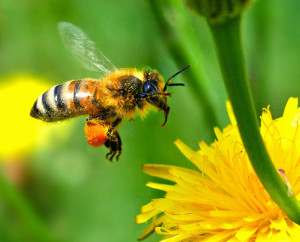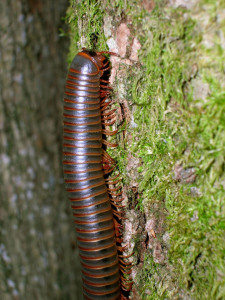Last week Deborah and I were down on Roaring Run with Rob and Michele Bridges getting ready for a late afternoon bike ride and walk when I saw a great cloud of honey bees hovering over a recently mowed area near the start of the trail. I hadn’t seen such a dense crowd of honey bees along this trail in years and so went over to watch them.
The bees were very calm but also very intent in their search patterns over the freshly cut area. They kept landing and rising and moving from spot to spot in a very random but, somehow, very orderly manner. It was like they were going from flower to flower in a field, but there were no flowers in their search area. I did see a number of cut violet leaves in the low growing plant mix of the “lawn,” and I wondered if the bees might have been foraging among the violets prior to the mowing and then have continued to receive and interpret chemical “flower” signals even after the flowers had been torn away? When I came back to the trail head after an hour and half of riding all of the bees were gone. Very curious, indeed.
Last week I noted a lack of forest millipedes on Roaring Run (compared to previous years), but I am very glad to report that they are back in their expected numbers! Rob and I had to keep our eyes on the trail ahead because there were dozens and dozens of them (called the “North American millipede,” Narceus americana) crossing the path in front of our bikes. These millipedes thrive in cool, moist forests that are full of leaf and woody debris. They are important components of the decomposer web by which carbon in plant materials is converted into soil organic matter and nutrients are recycled for new plant growth. They are large but quite harmless to people. They can, if they are disturbed, however, secrete a yellow liquid that can stain your fingers. These millipedes are eaten by many birds, amphibians and reptiles, and they are a particularly favorite food of shrews. I managed not to run any of them over, but there had been some millipedes beforehand that had not been so lucky.
I am still searching for several of our expected migrant bird species! Today, Deborah and Michele saw a male and female rose-breasted grosbeak flying together across the path near the start of the trail, but there are many other species that are still “missing.” I have not yet seen a scarlet tanager or an indigo bunting, although both of these birds are expected summer residents along Roaring Run. I also haven’t seen or heard any wood thrushes, another expected species along this trail. I did see a hermit thrush in Harrison Hills Park and may have even spotted its nest, but I want to hear the wild, fluting song of a wood thrush before I can really acknowledge that summer has arrived! Sometimes you just get out of phase with these birds: your time of looking just doesn’t match up with their time of activity. I need to shift my bird-biking trips to other times of day!
Just past the three mile marker along the bike trail we saw an early patch of fire pink growing out of the crumbling soil of an exposed slope. Its bright red petals stood out sharply against the bare, black soil of the slopes. Fire pink was the flower that Deborah and I saw every day of our Baker Trail hike five years ago. As we hiked north in the early summer, we followed its blooming phases all the way up into the Allegheny Forest.
Our bluebird nesting project up at Harrison Hills Park is going along very nicely! We have decided to call ourselves the “Cavity Nesting Team” because of the abundance of not only bluebirds but also tree swallows that are utilizing our nest boxes. The team has steadily dealt with repairs to the poles and boxes, wasps, house sparrows, and most recently explosively growing poison ivy and the specter of deer ticks along our access paths. The team celebrated the first hatching of “our” bluebirds with a level of joy usually reserved for new additions to one’s family! Our data so far: four boxes have confirmed bluebird nests with eggs (above is a photo of bluebird eggs in one of our boxes!), and, as of mid-May, three of these boxes have nestlings (a total of twelve to fifteen baby birds (they are very hard to count when they are all smushed together in the nest!)). Five of the nestlings fledged last week, and we will be checking the boxes to see if the others have followed suit! Five boxes have confirmed tree swallow nests, and four of these nests contain 4 to 5 eggs (no nestlings as of last week, but we’ll check again this weekend!). Two boxes had house sparrow nests, and one box has a wren nest. I will let you know how fledging goes over the next few weeks!
Summer is here! Enjoy!





sounds like you saw a swarm of honey bees in travel mode. They act like you described.
We are not seeing Spring Migration birds as we did last year. No tanagers, no grosbeaks, no indigo buntings, no Baltimore orioles. But tons of starlings. More than I ever remember visiting our feeders. But at least the hummingbirds are back. Happy to have them.